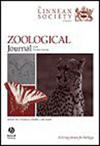The appendicular osteology of the Early Jurassic theropod Piatnitzkysaurus floresi and its implications on the morphological disparity of non-coelurosaurian tetanurans
IF 2.8
2区 生物学
Q1 ZOOLOGY
引用次数: 0
Abstract
Piatnitzkysaurus floresi is a theropod dinosaur from the Cañadón Asfalto Formation (Chubut Province, Argentina) and one of the few Early Jurassic tetanurans known worldwide. This species is known from two specimens and plays a key role in our understanding of the early evolution of tetanuran theropods. Nevertheless, the published information about its postcranium is limited to the original description of the 1980s and drawings in a few views. Here, we redescribe in detail the appendicular skeleton of Piatnitzkaysaurus and integrate new information into new phylogenetic and morphological disparity analyses focused on non-coelurosaurian tetanurans. Our results agree with recent studies that place Piatnitzkysauridae (including Condorraptor, Marshosaurus, Piatnitzkysaurus, and Xuanhanosaurus) as the earliest diverging group of Allosauroidea and within a monophyletic Carnosauria (Allosauroidea + Megalosauroidea). Morphological disparity analyses of the appendicular skeleton of non-coelurosaurian tetanurans show that the Jurassic species occupy a different morphospace from the Cretaceous species. Condorraptor and Piatnitzkysaurus are found within the morphospace occupied by the Middle Jurassic species from the Northern Hemisphere, which indicates the presence of similar body plans for the non-coelurosaurian tetanurans during the Early–Middle Jurassic worldwide. The new information about Piatnitzkysaurus improves our knowledge about the evolution of early tetanurans.早侏罗世兽脚亚目Piatnitzkysaurus floresi的尾骨学特征及其对非硬骨龙破伤风目形态差异的启示
Piatnitzkysaurus floresi是一种兽脚亚目恐龙,来自Cañadón Asfalto组(阿根廷Chubut省),是世界上为数不多的早侏罗世破伤风类恐龙之一。这个物种从两个标本中已知,在我们了解破伤风龙兽脚亚目的早期进化中起着关键作用。然而,关于它的头盖骨的公开信息仅限于20世纪80年代的原始描述和少数视图中的绘图。本文对Piatnitzkaysaurus的附属骨进行了详细的描述,并将新信息整合到以非腔龙破伤风目为重点的系统发育和形态差异分析中。我们的研究结果与最近的研究结果一致,即Piatnitzkysauridae(包括Condorraptor、Marshosaurus、Piatnitzkysaurus和Xuanhanosaurus)是异特龙总科最早的分化类群,属于单系食肉龙总科(异特龙总科+巨龙总科)。对非虚骨龙破伤风龙尾骨的形态差异分析表明,侏罗纪破伤风龙与白垩纪破伤风龙占据不同的形态空间。在北半球中侏罗世物种所占据的形态空间中发现了盗龙和Piatnitzkysaurus,这表明早中侏罗世世界范围内非骨龙破伤风龙的身体结构相似。关于Piatnitzkysaurus的新信息提高了我们对早期破伤风类进化的认识。
本文章由计算机程序翻译,如有差异,请以英文原文为准。
求助全文
约1分钟内获得全文
求助全文
来源期刊
CiteScore
6.50
自引率
10.70%
发文量
116
审稿时长
6-12 weeks
期刊介绍:
The Zoological Journal of the Linnean Society publishes papers on systematic and evolutionary zoology and comparative, functional and other studies where relevant to these areas. Studies of extinct as well as living animals are included. Reviews are also published; these may be invited by the Editorial Board, but uninvited reviews may also be considered. The Zoological Journal also has a wide circulation amongst zoologists and although narrowly specialized papers are not excluded, potential authors should bear that readership in mind.

 求助内容:
求助内容: 应助结果提醒方式:
应助结果提醒方式:


